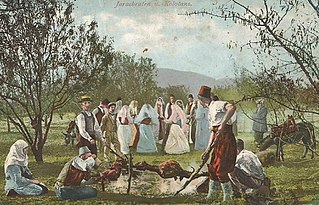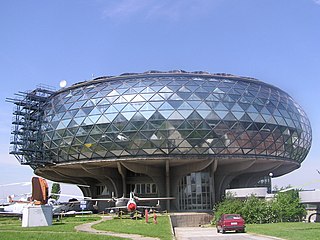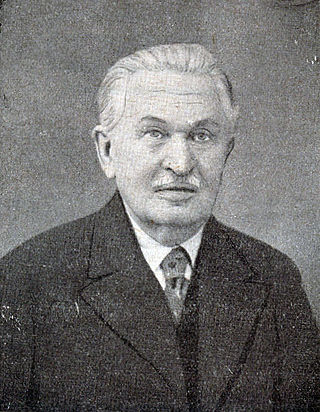
The culture of Bosnia and Herzegovina encompasses the country's ancient heritage, architecture, science, literature, visual arts, music, cinema, sports and cuisine.

The Aga Khan Award for Architecture (AKAA) is an architectural prize established by Aga Khan IV in 1977. It aims to identify and reward architectural concepts that successfully address the needs and aspirations of Muslim societies in the fields of contemporary design, social housing, community development and improvement, restoration, reuse and area conservation, as well as landscape design and improvement of the environment.
The year 1983 in architecture involved some significant architectural events and new buildings.

Visoko is a city located in the Zenica-Doboj Canton of the Federation of Bosnia and Herzegovina, an entity of Bosnia and Herzegovina. As of 2013, the municipality had a population of 39,938 inhabitants with 11,205 living in Visoko town. Located between Zenica and Sarajevo, Visoko lies where the river Fojnica joins the Bosna.
The architecture of Bosnia and Herzegovina is largely influenced by four major periods, when political and social changes determined the creation of distinct cultural and architectural habits of the region.

The Jewish people of Bosnia and Herzegovina are one of the minority peoples of Bosnia and Herzegovina, according to country's constitution. The history of Jews in Bosnia and Herzegovina spans from the arrival of the first Bosnian Jews as a result of the Spanish Inquisition to the survival of the Bosnian Jews through the Holocaust and the Yugoslav Wars. Judaism and the Jewish community in Bosnia and Herzegovina have one of the oldest and most diverse histories of all the former Yugoslav states, and is more than 500 years old, in terms of permanent settlement. Then a self-governing province of the Ottoman Empire, Bosnia was one of the few territories in Europe that welcomed Jews after their expulsion from Spain.
Ivan Ceresnjes, also known as Ivica Ceresnjes, is a Bosnian architect-researcher at the Center for Jewish Art at the Hebrew University of Jerusalem specializing in the documentation of the Jewish architectural-cultural heritage in the former Yugoslavia and Eastern Europe. During the Bosnian War of 1992–1995 he served as the president of the Jewish community of Bosnia and Herzegovina, and played a central role in the rescue and evacuation of thousands of Sarajevo residents.

Art of Bosnia and Herzegovina refers to artistic objects created by the inhabitants of Bosnia and Herzegovina from prehistory to present times.

Šerefudin's White Mosque is a mosque located in Visoko, Bosnia and Herzegovina. It is of great architectural importance to the city and area. The mosque's architect was Zlatko Ugljen, the craftsman was Ismet Imamović, while the contractor was Zvijezda from Visoko. Original mosque was built in 1477, but it was completely reconstructed and finished in 1980. It received its most notable award in 1983, when it received the Aga Khan Award for Architecture. The jury commended the mosque for its boldness, creativity and brilliance, as well as its originality and innovation. In 2007 it received another recognition, this time from Hungarian architects for being one of the three best designed places of worship in Europe.
Habib Fida Ali was one of Pakistan's most prominent architects, working in the modernist tradition.

Ivan Štraus was a Bosnian architect.

Karel Pařík was a Czech-born architect in the Austro-Hungarian empire. Pařík spent most of his life in Sarajevo where he designed over seventy major buildings, which are today classified among the most beautiful in Bosnia and Herzegovina. For Bosnians, he is also known as Karlo Paržik and is considered as "The builder of Sarajevo". He died working on his last project, Sarajevo City Hall, which later became one of the symbols of the city. "Czech by birth, Sarajevan by choice" stands encrypted on his gravestone in Sarajevo.

Josip Vancaš was an Austro-Hungarian and Yugoslav architect who spent most of his career in the Bosnian city of Sarajevo, where he designed over two hundred buildings. He also designed important buildings in present-day Croatia and Slovenia. He was also the first conductor of the Männer-gesang-verein in Sarajevo, at its founding in 1887.
Azra Akšamija is a Bosnian-Austrian artist and architectural historian. Her work focuses on the role of cultural and religious identity in conflicts, especially in the recent history of the Bosnian War and its aftermath. Akšamija is currently a professor at the Art, Culture and Technology program at the Massachusetts Institute of Technology (MIT).
Turgut Cansever was a Turkish architect and city planner. He is the only architect to win the Aga Khan Award for Architecture three times. He is known as "The Wise Architect". He took charge in many towns, zoning, and protected area projects. He designed Beyazıt Square and was the author of the first art history doctoral thesis in Turkey.

Živorad "Žika" Janković (1924–1990) was a Yugoslav and Bosnian architect.

Zlatko Topčić is a Bosnian screenwriter, playwright and novelist. He has written a number of films, including: Remake, The Abandoned, Miracle in Bosnia; theater plays: Time Out, I Don't Like Mondays, Refugees; novels: The Final Word, Dagmar, June 28, 1914.

Boris Magaš was a Croatian architect and architectural theorist, former Secretary of the Croatian Academy of Sciences and Arts and recipient of the Croatian National order of chivalry Order of Danica Hrvatska "Marko Marulić" for culture. He is best known for the Poljud stadium in Split and the Historical Museum of Bosnia and Herzegovina in Sarajevo.

The Walled city of Vratnik, also Old Vratnik Fort, is located in Vratnik neighborhood, in Sarajevo, Bosnia and Herzegovina. It represents urban core within the wider neighbourhood of the same name. Since 2005 the KONS designated walled area of the neighborhood a national monument of Bosnia and Herzegovina.













